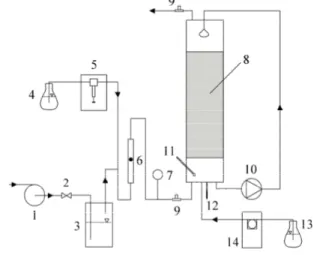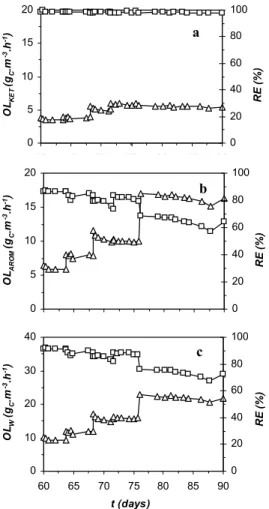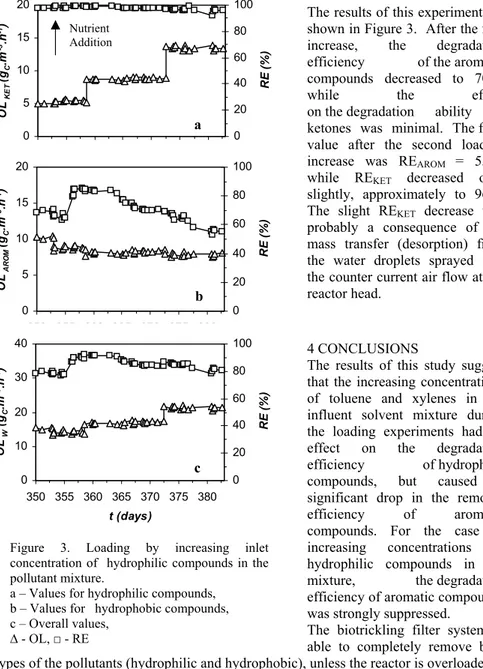TítuloPaint solvent components degradation from their mixture along the biotrickling bed height
Texto completo
(2) 372. J. PACA, E. KLAPKOVA, M. HALECKY AND K. JONES. 2 MATERIALS AND METHODS A schematic diagram of the bench-scale biotrickling filter is shown in Figure 1. The bioreactor was constructed of three cylindrical units. The two upper units were made of glass and the sump was made of polypropylene. The height of the reactor was 1.7 m and the internal diameter was 0.15 m. The sump was separated from the column by a perforated plate. The packing material consisted of Pall rings made of hydrophilized polypropylene. The column was packed with Pall rings having the following characteristics: 15 x15 x 1 mm, void volume of 0.8624, specific surface area of 350 m2.m-3 and a bulk density of 120 kg.m-3. The packed bed height was 1 m. The mixed microbial culture used to inoculate the biotrickling filter included the following bacterial strains: Sphingobacterium multivorum (Grods), Comamonas testosteroni (Grods), Pseudomonas putida (G- rods) and Chryseobacterium indologenes (G- rods). The medium composition for cultivation consisted of (g.L1 ): K2HPO4 4.3; KH2PO4 3.4; KNO3 2; MgCl2 . 6 H2O 0.34; FeSO4 6.10-4; Na2MoO4 1. 10-5. Key biodegradation Figure 1. Schematic of the experimental set-up experimental conditions 1- blower, 2 - needle valve for air-flow rate control, 3 included: temperature of humidifier, 4 - vessel with pollutant, 5 - syringe pump, 6 22°C, a mineral medium rotameter, 7 - manometer, 8 - packing, 9 - sampling ports, 10 - membrane pump, 11 - pH electrode, 12 - thermometer, 13 - (MM) for growth which contained 0.75 g/L NaOH solution, 14 - peristaltic pump. (NH4)2SO4, 0.37 g/L KNO3, 0.1 g/L NaCl, 0.8 g/L K2HPO4, 0.6 g/L KH2PO4, 0.34 g/L MgCl2.6H2O, and 1 mL/L trace elements. The MM was present during the first month of operation. After this time period, tap water was used during the following months of experiments and the MM was added in small quantities when necessary. The pH of the circulating water phase was maintained at 7.0. The hydraulic loading rate was 0.0064 m.h-1. The synthetic waste gas influent included toluene, xylene (technical grade), methyl ethyl ketone (MEK), methyl isobutyl ketone (MIBK), and n-butyl acetate (n-BA). The VOCs in the gas phase were measured using an Agilent 6890 N gas chromatograph equipped with an ultra alloy-5 (5 % phenylmethylsilicone) capillary column of 30 m in length, the inner diameter of 0.53 mm, and film thickness of 1.5 µm (Quadrex Corp., UA5 - 30V - 1.5 F, New Haven, CT). The carrier gas used was ultra high purity argon at a flow rate of 5 mL.min-1. Detection was accomplished with a flame ionization detector (FID) with ultra high purity hydrogen and breathing quality air at flow rates of 28 mL.min-1 and 315 mL.min-1, respectively. GC operating conditions were as follows: column temperature, 80 °C; FID temperature, 250 °C..
(3) PAINT SOLVENT COMPONENTS DEGRADATION FROM THEIR MIXTURE ALONG THE BIOTRICKLING BED HEIGHT. 373. 3 RESULTS AND DISCUSSION. RE (%). OLAROM (g C.m -3.h -1). RE (%). OLKET (g C.m -3.h -1). 3.1 Effects of increasing hydrophobic compound concentrations in the influent mixture Figure 2 shows the organic loading (OL) and removal efficiency (RE) of the bioreactor. This experiment was carried out using tap water as the circulating medium. The biotrickling filter was loaded simultaneously with all the pollutants listed above. On day 64 the toluene concentration was increased from 50 mg.m-3 to 70 mg.m-3 in one step. The second change of the organic load was carried out on day 67 by increasing the inlet concentration (Cin) of both the aromatic compounds (toluene from 100 20 70 mg.m-3 to 80 mg.m-3, xylenes from 50 mg.m-3 to 80 mg.m-3), and a 80 15 the third increase on day 76 60 (toluene from 70 mg.m-3 to 110 10 mg.m-3, xylenes from 80 mg.m-3 to 40 100 mg.m-3). With these 5 adjustments, the value of the 20 organic loading of aromatics 0 0 (OLAROM) was increased from 6 60 65 70 75 80 85 90 gC.m-3.h-1 to 16 gC.m-3.h-1. 100 20 Increasing the content of the b hydrophobic compounds in the 80 15 mixture resulted in a drop of the 60 removal efficiency of hydrophobic 10 compounds from 90% to 60% (Fig. 40 2b). However, the value of REKET 5 remained constant. 20 3.2 Effects of increasing hydrophilic compound 100 40 concentrations in the influent c mixture 80 30 In this phase of the experimental 60 work, the biotrickling filter was 20 loaded with a mixture of VOC 40 solvents with gradually increasing 10 20 inlet concentrations of the hydrophilic compounds. Prior to 0 0 this experiment, salts for 3L of MM 60 65 70 75 80 85 90 were added in order to improve t (days) the degradation efficiency of Figure 2. Loading by increasing inlet toluene and xylenes. The salts were concentration of hydrophobic compounds in the added on the 355th day of pollutant mixture. operation, and within 24 hours after a – Values for hydrophilic compounds, addition the total degradation b – Values for hydrophobic compounds, efficiency of 85% was restored. c – Overall values, The inlet concentration of ¨ - OL, Ƒ - RE hydrophilic compounds was increased in two steps, from 5 gC.m-3.h-1 to 9 gC.m-3.h-1 and subsequently to 14 gC.m-3.h1 . Simultaneously, the concentration of influent aromatic compounds was kept constant. 0. 0. 65. 70. 75. 80. 85. 90. RE (%). OLW (gC.m -3.h -1). 60.
(4) 374. J. PACA, E. KLAPKOVA, M. HALECKY AND K. JONES. Nutrient Addition. 80 60. 10. 40. 5. 20. a. 0 350 355 360 365 370 375 380 20 OL AROM (gC.m -3.h-1). RE (%). 15. 100. 0 100 80. 15. 60 10 40 5. b. 0 350 355 360 365 370 375 380 40. RE (%). OL KET (gC.m -3.h-1). 20. 20. The results of this experiment are shown in Figure 3. After the first increase, the degradation efficiency of the aromatic compounds decreased to 70%, while the effect on the degradation ability of ketones was minimal. The final value after the second loading increase was REAROM = 55%, while REKET decreased only slightly, approximately to 96%. The slight REKET decrease was probably a consequence of the mass transfer (desorption) from the water droplets sprayed into the counter current air flow at the reactor head.. 0 100. RE (%). OL W (gC.m -3.h-1). 4 CONCLUSIONS The results of this study suggest 80 30 that the increasing concentrations 60 of toluene and xylenes in the 20 influent solvent mixture during 40 the loading experiments had no 10 effect on the degradation 20 efficiency of hydrophilic c 0 0 compounds, but caused a 350 355 360 365 370 375 380 significant drop in the removal efficiency of aromatic t (days) compounds. For the case of increasing concentrations of Figure 3. Loading by increasing inlet concentration of hydrophilic compounds in the hydrophilic compounds in the pollutant mixture. mixture, the degradation a – Values for hydrophilic compounds, efficiency of aromatic compounds b – Values for hydrophobic compounds, was strongly suppressed. c – Overall values, The biotrickling filter system is ¨ - OL, Ƒ - RE able to completely remove both types of the pollutants (hydrophilic and hydrophobic), unless the reactor is overloaded. 5 ACKNOWLEDGEMENT This study was financially supported by the Czech Science Foundation, Joint Project 104/05/0194 and the Ministry of Education of the Czech Republic, Research Project MSM 6046137305..
(5) PAINT SOLVENT COMPONENTS DEGRADATION FROM THEIR MIXTURE ALONG THE BIOTRICKLING BED HEIGHT. 375. 6 REFERENCES Cox, H.H.J., Deshusses, M.A. (2002) Co-treatment of H2S and toluene in a trickling filter. Chem. Eng. J. 87: 101-110. Delhoménie, M. C., Bibeau, L., Gendrom, J., Brzezinski, R. and Heitz, M. (2001) Toluene removal by biofiltretion: influence of the nitrogen concentration on operational parameters. Ind. Eng. Chem. Res. 40 (23): 5405-5414. Kim, D., Cai, Z.and Sorial, G. A. (2004a) Impact of interchanging VOCs on the performance of trickle-bed air biofilter. Proceedings 2004 USC-TRG Conference on Biofiltration, Reynolds Jr. F.E., Ed., The Reynolds Group, Redondo Beach, CA, pp. 35. Kim, D., Cai, Z. and Sorial, G.A. (2004b) Evaluation of trickle-bed air biofilter performance for removal of paint booth VOCs under stressed operating conditions. Proceedings of A&WMA´s 97th Ann. Conference & Exhibition, Indianopolis, 2004, Paper 36. Paca, J., Klapkova, E. and Halecky, M. (2004) Paint Solvent Mixture Removal in Biotrickling Filter. Proceedings of 2004 Conference on Biofiltration for air pollution control, Ed. J. S. Devinny, Edited by USC Center for Sustainable Cities, Los Angeles, CA, pp. 43-50. Park, J. and Kinney, K. A. (2002) Investigation of a polyurethane foam biofilter: effect of operating mode and nutrient supply. Proceedings of A&WMA´s 95th Ann. Conference & Exhibition, Baltimore, ME, USA, Paper 43170. Qi, B., Moe, W. M. and Kinney, K. A. (2002) Biodegradation of volatile organic compounds by five fungal species. Appl. Microbiol Biotechnol. 58: 684-689. Song, J.H., Kinney, K.A. and Cooke, J. (2002a) Effect of nitrogen availability on paint VOC mixtures removal. Proceedings 2002 USC-TRG Conference on Biofiltration, Reynolds Jr. F.E., Ed., The Reynolds Group, Tustin, CA, pp. 191. Song, J.H., Kinney, K.A., Boswell, J. T., John, P. C. (2002) Performance of a compost-based hybrid bioreactor for the treatment of paint spray booth emissions. Proceedings of A&WMA´s 95th Ann. Conference & Exhibition, Baltimore, ME, USA, Paper 43055..
(6)
Figure



Documento similar
In the previous sections we have shown how astronomical alignments and solar hierophanies – with a common interest in the solstices − were substantiated in the
Summing up, a proper concentration of PbS QDs results in an impressive shift (ΔT = 45°C if the solvent is DMF and ΔT = 80 °C if the solvent is the DMSO) of the perovskite
Díaz Soto has raised the point about banning religious garb in the ―public space.‖ He states, ―for example, in most Spanish public Universities, there is a Catholic chapel
Parameters of linear regression of turbulent energy fluxes (i.e. the sum of latent and sensible heat flux against available energy).. Scatter diagrams and regression lines
It is generally believed the recitation of the seven or the ten reciters of the first, second and third century of Islam are valid and the Muslims are allowed to adopt either of
In the “big picture” perspective of the recent years that we have described in Brazil, Spain, Portugal and Puerto Rico there are some similarities and important differences,
In the preparation of this report, the Venice Commission has relied on the comments of its rapporteurs; its recently adopted Report on Respect for Democracy, Human Rights and the Rule
We seek to characterize the transport in a time-dependent flow by identifying coherent structures in phase space, in particular, hyperbolic points and the associated unstable and